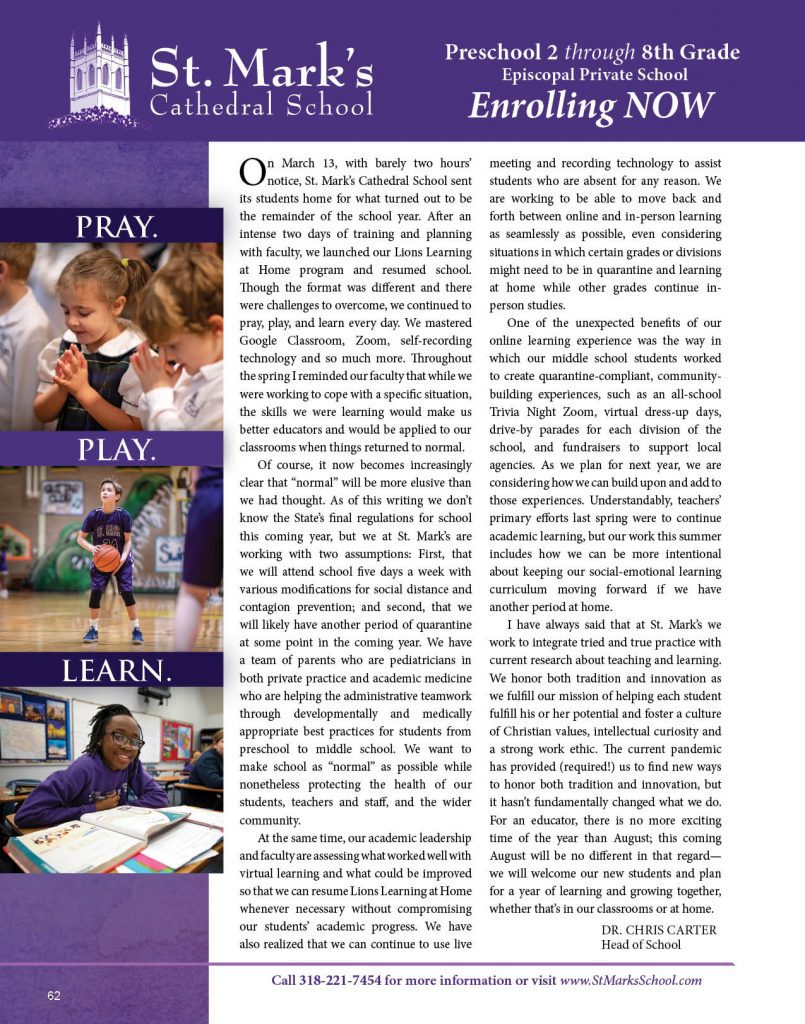Local education leaders speak about the new, unique challenges of going back to school in 2020
Cedar Creek School
As the 2019-20 school year came to a close, thoughts of August came to mind. I have read numerous articles, reports, and guides and have been a part of many virtual and face-to-face meetings. I want parents and students to know that Cedar Creek will be back to school in August. The plan is for Cedar Creek School to open on August 13 as scheduled and be in school five days a week from 8:00-3:00. Our staff will teach, coach, and nurture our students as we have been doing for 50 years. We will continue to monitor events and guidelines as we move through the summer and may make a few changes in certain areas, such as foodservice and cleaning procedures, but we will continue the outstanding education that is expected from Cedar Creek School.
I wish each of you a wonderful, restful, and healthy summer!
~Andrew Yepson, Cedar Creek
Caddo Parish leadership outlines possible options for reopening school
Caddo Schools is actively preparing to reopen schools this fall with the safety of students and staff as the top priority. These plans include a traditional model, hybrid model, and virtual model of operating schools.
Caddo’s commitment is to provide students with opportunities to minimize the impact of lost instructional time, including remediation, regardless of the restrictions in place at a given time. To support this commitment, the district is in the process of securing additional devices to provide technology access to students, and Caddo will work with families through community partnerships to access Internet connectivity where issues may arise.
The district is currently working with school staff, including teachers and administrators, to provide training and supports on virtual resources and how to enhance virtual instruction. Caddo also will offer training and supports to students and families to assist them in using the learning management system.
“I am incredibly proud of our teachers and staff, and the incredible way they completely changed the way they delivered instruction in a matter of a week last March,” said Dr. Lamar Goree, Superintendent of Caddo Schools. “Moving forward, we must build off of the lessons learned in the spring and provide an instructional model that is faster in implementation and provides greater support of our students and families.”
In accordance with current guidance, all models of instruction call for adults and students in middle and high schools to wear masks to the maximum extent possible. Individuals with severe breathing difficulties should not wear masks.
In the Traditional Model of district operations, Caddo students will report to schools on Aug. 10 with the district allowing for face-to-face instruction as well as an all-virtual model for students whose families do not feel comfortable with students returning to campuses. In this model, elementary students will remain in static groups, and middle and high school students may be allowed to change classes while maintaining social distancing. Students deemed medically fragile or high risk will be provided virtual instruction.
The district will also follow social distancing guidance and provide frequent opportunities for handwashing for all students and staff. Breakfast and lunch will be provided through the district’s “grab and go” system and will be scheduled in classrooms and other designated areas.
Burton also presented a Hybrid Model, which would limit campuses to a 50 percent capacity with a virtual model of instruction available.
The Hybrid Model would allow the district as early as the first day of school to begin the year using an “A/B” schedule. The schedule would allow for all students on Mondays to access instruction virtually while Tuesdays and Thursdays would be an “A” day and Wednesdays and Fridays for a “B” day. Students would be grouped in alphabetical order for middle and high schools to determine students on campus versus those receiving instruction virtually every day. Elementary school students would be grouped as deemed appropriate by their principal. The district also will work with families to evaluate individual adjustments to keep siblings together, improve transportation routes or other needs.
A student’s selection of all virtual instruction or an “A/B” schedule is for a minimum of a 9-week period.
In the Hybrid Model, multiple meals will be provided for all students to take home for the days they are not at school. Schools will also designate specific entry and exit points, and no assemblies will be allowed. Visitors will not be able to enter buildings unless there are extenuating circumstances.
Building off the model launched in March following facility closures statewide, Caddo has spent recent weeks reviewing its areas of success and growth in virtual instruction. The Virtual Model proposed for the 2020-2021 school year will require the district to implement a new learning management system to better support students and teachers. Instruction through this system will be provided using a dual model of live virtual education as well as on-demand lessons. Teachers will receive coaching and feedback on the quality of resources and instructional delivery for school leadership teams.
The district will provide meals for the week each Monday, as is currently taking place. The Virtual Model will not allow public access into district schools or sites.
In all models, it is important for families to note student work will be assessed and graded.
~Dr. Theodis Lamar Goree, Superintendent, Caddo Parish Schools
Bossier Parish Schools
As the conversation about the pandemic continues to evolve, so do guidelines and directives, making it premature to definitively say what the 2020-21 school year will look like in Bossier Parish. Right now, it is our intent to have a traditional start to the school year, but with modifications that comply with the Centers for Disease Control and Louisiana Department of Health. A virtual learning program will also be provided as an alternative for elementary-age children that complements the middle and high school virtual platforms already in place, and there are discussions about a hybrid platform as well.
It is important to note these plans are contingent upon Louisiana going into Phase 3 and subject to change, depending on the course COVID-19 takes, and Bossier Schools will follow the lead of our governor and state superintendent of education.
~Mitch Downey, Superintendent, Bossier Schools
St. Mark’s Cathedral School
On March 13, with barely two hours’ notice, St. Mark’s Cathedral School sent its students home for what turned out to be the remainder of the school year. After an intense two days of training and planning with faculty, we launched our Lions Learning at Home program and resumed school. Though the format was different and there were challenges to overcome, we continued to pray, play, and learn every day. We mastered Google Classroom, Zoom, self-recording technology and so much more. Throughout the spring I reminded our faculty that while we were working to cope with a specific situation, the skills we were learning would make us better educators and would be applied to our classrooms when things returned to normal.
Of course, it now becomes increasingly clear that “normal” will be more elusive than we had thought. As of this writing we don’t know the State’s final regulations for school this coming year, but we at St. Mark’s are working with two assumptions: First, that we will attend school five days a week with various modifications for social distance and contagion prevention; and second, that we will likely have another period of quarantine at some point in the coming year. We have a team of parents who are pediatricians in both private practice and academic medicine who are helping the administrative teamwork through developmentally and medically appropriate best practices for students from preschool to middle school. We want to make school as “normal” as possible while nonetheless protecting the health of our students, teachers and staff, and the wider community.
At the same time, our academic leadership and faculty are assessing what worked well with virtual learning and what could be improved so that we can resume Lions Learning at Home whenever necessary without compromising our students’ academic progress. We have also realized that we can continue to use live meeting and recording technology to assist students who are absent for any reason. We are working to be able to move back and forth between online and in-person learning as seamlessly as possible, even considering situations in which certain grades or divisions might need to be in quarantine and learning at home while other grades continue in-person studies.
One of the unexpected benefits of our online learning experience was the way in which our middle school students worked to create quarantine-compliant, community-building experiences, such as an all-school Trivia Night Zoom, virtual dress-up days, drive-by parades for each division of the school, and fundraisers to support local agencies. As we plan for next year, we are considering how we can build upon and add to those experiences. Understandably, teachers’ primary efforts last spring were to continue academic learning, but our work this summer includes how we can be more intentional about keeping our social-emotional learning curriculum moving forward if we have another period at home.
I have always said that at St. Mark’s we work to integrate tried and true practice with current research about teaching and learning. We honor both tradition and innovation as we fulfill our mission of helping each student fulfill his or her potential and foster a culture of Christian values, intellectual curiosity and a strong work ethic. The current pandemic has provided (required!) us to find new ways to honor both tradition and innovation, but it hasn’t fundamentally changed what we do. For an educator, there is no more exciting time of the year than August; this coming August will be no different in that regard—we will welcome our new students and plan for a year of learning and growing together, whether that’s in our classrooms or at home.
~Dr. Chris Carter, Head of School
Huntington High School poised to meet students’ needs as school resumes
As schools prepare to open in the fall in the midst of a looming health crisis, the most significant issue they have to address, outside of students’ health, is a growing concern for their ability to offer students a quality education at home.
The COVID emergency left teachers and administrators working overtime to plan and deliver an education that most closely resembles a classroom experience. Students at Huntington High School were able to receive just that, thanks to the innovative efforts of teachers like Kesha McClendon. An educator for over 11 years who has taught African-American studies and civics at Huntington, McClendon had her students well versed in various virtual educational tools long before the schools moved to at-home learning. In the classroom, her students were using Google Classroom and completing activities on sites like Quizziz, NearPod, and EdPuzzle regularly.
“I began using Chrome Books the second day of school,” says McClendon. “Getting students accustomed to using Google Classroom made it easy to transition to virtual learning.” Because her students were so proficient in using technology, their transition to at-home learning went smoothly, and they understood they had accountability to McClendon for completing their work.
“My students understood my expectations for virtual learning,” she explains. “Using technology daily in the classroom helped eliminate the excuses when we made the transition to virtual learning.” Because of these expectations and her familiarity with the sites and virtual assignments that captivated her students’ imaginations and fueled their desire to learn, McClendon had good success in keeping her students engaged when learning from home.
This year she plans to expand what she has taught her students in the past by including rubrics specifically designed for virtual learning. “I also plan to create a ‘how to’ guide for parents to be sent home with the syllabus,” McClendon explains. As this year begins, she “would like to give parents the opportunity to learn these platforms as well as address any of their questions before there is another untimely emergency that forces us to virtual learning,” she says. By offering parents the help they need to learn how to access and use this technology, McClendon hopes that she can help parents feel confident in their ability to be more directly involved in their children’s education from home.
With such uncertainty surrounding what the next school year holds across the nation, it is comforting to know we have schools here at home that are both flexible and innovative in the way they are supporting parents and students. Our community has learned quickly that a child’s education can either be bolstered or can suffer tremendously when learning from home becomes a necessity. Thankfully, there are administrators and teachers like those at Huntington who are committed to ensuring their students get everything they need to receive the best quality education available, regardless of extenuating circumstances.
~Kesha McClendon, Huntington High School










